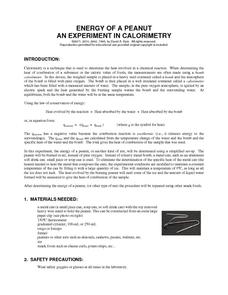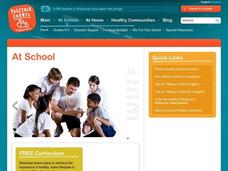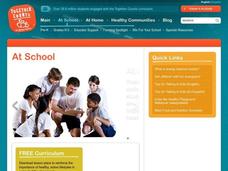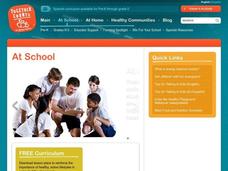Captain Planet Foundation
Energy Flow in the Garden
How can you tell what an owl has eaten? Study the food chain and flow of energy in an ecosystem by dissecting an owl pellet and noting the bones found inside. Additionally, the instructional activity includes a game about consumers and...
University of Georgia
Energy Content of Foods
Why do athletes load up on carbohydrates the evening before a competition? The lesson plan helps answer this question as it relates the type of food to the amount of energy it contains. After a discussion, scholars perform an experiment...
Chymist
Energy of a Peanut
Are you nuts? An engaging experiment burns nuts to find their kilocalories. Young chemists analyze at least two different types of nuts with their experimental results versus what is on the package. The resource offers a great lab for...
Baylor College
Food for Kids
Immediately capture the attention of your class with the smell of freshly popped popcorn in the sixth lesson of this series on the needs of living things. Young scientists first use their senses to make and record observations of...
Curated OER
What is Energy?
Youngsters take a look at the foods they eat, and how they provide energy for them to do things. They look at how body uses the food energy to create movement. Pupils also look at toys/devices in the room that need electrical energy...
Virginia Department of Education
Freshwater Food Chains
What's in the water? Encourage your class to further explore this question and learn about pond ecosystems, food chains, and food webs as they complete this hands-on activity. They view the environment from a new perspective after...
Curated OER
Food Energy
Students compare the energy value of traditional foods eaten by indigenous people with those of modern commercial foods. They use a calorimeter to measure and calculate the amount of stored energy in various food types, and identify the...
Curated OER
Looking at Food Chains
In this Looking at Food Chains worksheet, students read about a food chain under the sea and underline important information. Next, students fill in a graphic organizer about food chains based on the information they just read.
Scholastic
Study Jams! Food Chains
Rhinozilla is Mia's bearded dragon and the focus of this lesson on energy flow in an ecosystem. She uses him to explain the energy pyramid, from producers through third level consumers, and she likens the food chain to a video game. Mia...
Serendip
Food, Energy and Body Weight
High schoolers learn why humans need calories, how they control weight with food choices, and the impact of exercise on energy. Scholars then apply their understanding to a case study of lunch choices and exercise.
Curated OER
Discovering Local Food Chains
Fourth graders study about food chains. With the assistance of a local biologist, Students hike the school trail system. They explore ecosystem and collect data by charting the organisms found and identifying the energy source. They...
Curated OER
The Absorption of Solar Energy
Two sequential parts to this lesson introduce your class to the electromagnetic spectrum, the ability to absorb radiant energy, and the pigments in leaves that are responsible for collecting sunlight to be used in the photosynthetic...
Curated OER
Food Energy and Nutrients
In this food energy and nutrients worksheet, students fill in the blank and complete a chart with information about food energy and essential nutrients needed for the body. Using the Nelson text, students complete a chart about...
NASA
Consumers Get Energy From Other Living Things
How do plants and animals get their food? Learn about where energy comes from, how animals store energy, and aerobic respiration, in a lesson that allows scholars to diagram energy flows.
Serendip
How Do Biological Organisms Use Energy?
When an organism eats, how does food become energy? Young biologists follow glucose through the process of cellular respiration to the creation of ADP using a discussion-based activity. The resource also highlights conservation of mass...
Curated OER
Energy Plus!
"Energy Plus!" from Together Counts is three days worth of lessons, discussions, and activities about nutrition. The materials help you teach youngsters about eating healthy and burning calories. Energy in and energy out. Included are...
NOAA
An Ocean of Energy
Young biologists trace the path of the sun's energy through marine ecosystems in the second part of this four-lesson series. Building on prior knowledge about producers, consumers, and decomposers young scholars are introduced to the...
Curated OER
Your Energy In
What are Dietary Guidelines? What are the basic principles of a sensible healthy diet? What do variety, balance, and moderation have to do with eating healthy. What are the food groups? There are a couple of activities in this...
Curated OER
Your Energy In
Help your youngsters make considerations about what they eat. Use this instructional activity as a jumping-off point to discuss dietary guidelines, the food pyramid, and major food groups. This creative instructional activity grabs...
Science Geek
Build a Food Web Activity
Entangle your life science class in learning with this collaborative food web activity. Using pictures of the plants and animals native to a particular ecosystem, young biologists work in small groups to construct visual representations...
Curated OER
Use Concept Maps to Teach the Transfer of Energy
Practical tips, lessons, and ideas for teaching the transfer of energy.
Curated OER
Energy Balance In Your Life
It's easy enough to put energy in, but not so easy to use it up! Look at food labels with your young learners and help them understand the concept of calories in and calories out. Food eaten means calories in and exercise means calories...
Curated OER
Energy Balance in Your Life
How do young learners figure out how to balance their energy in and their energy out? The main thing to understand is calories. How many calories are in foods and beverages consumed and how many calories are burned off by physical...
Curated OER
Your Energy Balance Goal!
This is the culminating activity for a unit on energy balance for 3rd-5th graders created by Together Counts. Young learners make a plan to balance their energy in and their energy out for one month. They use the SMART steps in creating...
Other popular searches
- Food Webs, Energy Pyramids
- Food Chain Energy Pyramid
- Food Energy Pyramid
- Chemical Energy and Food
- Food Webs Energy Pyramids
- Food Web Energy Transfer
- Chemical Energy Food
- Energy and Food Production
- Energy in Food
- Energy From Food
- Food Energy Kcal
- Food Energy Levels

























